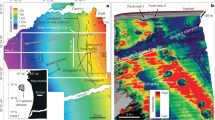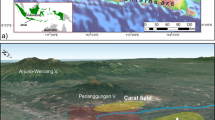Abstract
Methane, a potent greenhouse gas, is abundant in marine sediments1,2. Submarine seepage of methane-dominated hydrocarbons is heterogeneous in space and time, and mechanisms that can trigger episodic seep events are poorly understood2,3,4. For example, critical gas pressures have been predicted to develop beneath impermeable sediments that bear gas hydrates, making them susceptible to mechanical failure and gas release5,6. Gas hydrates often occur in seismically active regions, but the role of earthquakes as triggers of hydrocarbon seepage through gas-hydrate-bearing sediments has been only superficially addressed7,8. Here we present geochemical analyses of sediment cores retrieved from the convergent margin off Pakistan. We find that a substantial increase in the upward flux of gas occurred within a few decades of a Mw 8.1 earthquake in 1945—the strongest earthquake reported for the Arabian Sea. Our seismic reflection data suggest that co-seismic shaking fractured gas-hydrate-bearing sediments, creating pathways for the free gas to migrate from a shallow reservoir within the gas hydrate stability zone into the water column. We conservatively estimate that 3.26×108 mol of methane have been discharged from the seep site since the earthquake. We therefore suggest that hydrocarbon seepage triggered by earthquakes needs to be considered in local and global carbon budgets at active continental margins.
This is a preview of subscription content, access via your institution
Access options
Subscribe to this journal
Receive 12 print issues and online access
$259.00 per year
only $21.58 per issue
Buy this article
- Purchase on Springer Link
- Instant access to full article PDF
Prices may be subject to local taxes which are calculated during checkout




Similar content being viewed by others
References
Denman, K. L. et al. in IPCC Climate Change 2007: The Physical Science Basis (ed. Solomon, S.) (Cambridge Univ. Press, 2007).
Kvenvolden, K. A. & Rogers, B. W. Gaia’s breath—global methane exhalations. Mar. Petrol. Geol. 22, 579–590 (2005).
Tryon, M. D., Brown, K. M. & Torres, M. E. Fluid and chemical flux in and out of sediments hosting methane hydrate deposits on Hydrate Ridge, OR, II: Hydrological processes. Earth. Planet. Sci. Lett. 201, 541–557 (2002).
Tryon, M. D. Monitoring aseismic tectonic processes via hydrologic responses: An analysis of log-periodic fluid flow events at the Costa Rica outer rise. Geology 37, 163–166 (2009).
Flemings, P. B., Liu, X. & Winters, W. J. Critical pressure and multiphase flow in Blake Ridge gas hydrates. Geology 31, 1057–1060 (2003).
Hornbach, M. J., Saffer, D. M. & Holbrook, S. W. Critically pressured free-gas reservoirs below gas-hydrate provinces. Nature 427, 142–144 (2004).
Field, M. E. & Jennings, A. E. Seafloor gas seeps triggered by a northern California earthquake. Mar. Geol. 77, 39–51 (1987).
Halbach, P., Holzbecher, E., Reichel, T. & Moche, R. Migration of the sulphate-methane reaction zone in marine sediments of the Sea of Marmara can this mechanism be tectonically induced? Chem. Geol. 205, 73–82 (2004).
Kukowski, N. et al. Morphotectonics and mechanics of the central Makran accretionary wedge off Pakistan. Mar. Geol. 173, 1–19 (2001).
Heidarzadeh, M. et al. Historical tsunami in the Makran Subduction Zone off the southern coasts of Iran and Pakistan and results of numerical modeling. Ocean Eng. 35, 774–786 (2008).
Pendse, C. G. The Mekran earthquake of the 28th November 1945. India Meteorological Department Scientific Notes 10, 141–146 (1945).
Römer, M. et al. Quantification of gas bubble emissions from submarine hydrocarbon seeps at the Makran continental margin (offshore Pakistan). J. Geophys. Res. 117, C10015 (2012).
Ding, F. et al. Interaction between accretionary thrust faulting and slope sedimentation at the frontal Makran accretionary prism and its implications for hydrocarbon fluid seepage. J. Geophys. Res. 115, B08106 (2010).
Sibuet, M. & Olu, K. Biogeography, biodiversity and fluid dependence of deep-sea cold-seep communities at active and passive margins. Deep Sea Res. II 45, 517–567 (1998).
Fischer, D. et al. Interaction between hydrocarbon seepage, chemosynthetic communities, and bottom water redox at cold seeps of the Makran accretionary prism: Insights from habitat-specific pore water sampling and modeling. Biogeosciences 9, 2013–2031 (2012).
Hoehler, T., Alperin, M. J., Albert, D. B. & Martens, C. Field and laboratory studies of methane oxidation in an anoxic marine sediment: Evidence for a methanogen-sulfate reducer consortium. Glob. Biogeochem. Cycles 8, 451–463 (1994).
Torres, M. E., Brumsack, H. J., Bohrmann, G. & Emeis, K. C. Barite fronts in continental margin sediments: A new look at barium remobilization in the zone of sulfate reduction and formation of heavy barites in diagenetic fronts. Chem. Geol. 127, 125–139 (1996).
Dickens, G. R. Sulfate profiles and barium fronts in sediment on the Blake Ridge: Present and past methane fluxes through a large gas hydrate reservoir. Geochim. Cosmochim. Acta 65, 529–543 (2001).
Nöthen, K. & Kasten, S. Reconstructing changes in seep activity by means of pore water and solid phase Sr/Ca and Mg/Ca ratios in pockmark sediments of the Northern Congo Fan. Mar. Geol. 287, 1–13 (2011).
Kasten, S., Freudenthal, T., Gingele, F. X. & Schulz, H. D. Simultaneous formation of iron-rich layers at different redox boundaries in sediments of the Amazon deep-sea fan. Geochim. Cosmochim. Acta 62, 2253–2264 (1998).
Hensen, C. et al. Control of sulfate pore-water profiles by sedimentary events and the significance of anaerobic oxidation of methane for the burial of sulfur in marine sediments. Geochim. Cosmochim. Acta 67, 2631–2647 (2003).
Tishchenko, P., Hensen, C., Wallmann, K. & Wong, C. S. Calculation of the stability and solubility of methane hydrate in seawater. Chem. Geol. 219, 37–52 (2005).
Haeckel, M., Boudreau, B. P. & Wallmann, K. Bubble-induced porewater mixing: A 3-D model for deep porewater irrigation. Geochim. Cosmochim. Acta 71, 5135–5154 (2007).
Luff, R. & Wallmann, K. Fluid flow, methane fluxes, carbonate precipitation and biogeochemical turnover in gas hydrate-bearing sediments at Hydrate Ridge, Cascadia Margin: Numerical modelling and mass balances. Geochim., Cosmochim. Acta 67, 3403–3421 (2003).
Haeckel, M., Suess, E., Wallmann, K. & Rickert, D. Rising methane gas bubbles form massive hydrate layers at the seafloor. Geochim. Cosmochim. Acta 68, 4335–4345 (2004).
Wells, D. L. & Coppersmith, K. J. New empirical relationships among magnitude, rupture length, rupture width, rupture area, and surface displacement. Bull. Seismol. Soc. Am. 84, 974–1002 (1994).
Sahling, H. et al. Vodyanitskii mud volcano, Sorokin trough, Black Sea: Geological characterization and quantification of gas bubble streams. Mar. Pet. Geol. 26, 1799–1811 (2009).
Manga, M., Brumm, M. & Rudolph, M. L. Earthquake triggering of mud volcanoes. Mar. Petrol. Geol. 26, 1785–1798 (2009).
Acknowledgements
We thank M. Zabel for providing sulphate data. M. Römer kindly assisted in compiling the map and R. Alvaréz and M. Y. Yoshinaga assisted in the laboratory analyses. We acknowledge comments by T. Goldhammer and J. Collins on an earlier version of the manuscript. We thank Seismic Micro-Technology, (The KINGDOM Software) and GEDCO (Vista Windows Seismic Data Processing) for providing academic software licenses. This work has been supported through the DFG Research Centre/Cluster of Excellence ‘The Ocean in the Earth System’ (MARUM) with additional funding by the Helmholtz Association (Alfred Wegener Institute Helmholtz Centre for Polar and Marine Research, Bremerhaven).
Author information
Authors and Affiliations
Contributions
D.F. and S.K. designed the study and wrote the manuscript. D.F. and T.P. conducted the laboratory sample analyses. J.M.M. developed the numerical simulation. V.S. and N.F. processed and interpreted the seismic data and contributed to writing the manuscript. J.M.M., M.S., T.P. and G.B. substantially contributed to writing the manuscript.
Corresponding author
Ethics declarations
Competing interests
The authors declare no competing financial interests.
Supplementary information
Supplementary Information
Supplementary Information (PDF 1016 kb)
Rights and permissions
About this article
Cite this article
Fischer, D., Mogollón, J., Strasser, M. et al. Subduction zone earthquake as potential trigger of submarine hydrocarbon seepage. Nature Geosci 6, 647–651 (2013). https://doi.org/10.1038/ngeo1886
Received:
Accepted:
Published:
Issue Date:
DOI: https://doi.org/10.1038/ngeo1886
This article is cited by
-
Identification and Characteristics Analysis of Micro-Seismic Signals in the Haima Seep Area
Journal of Earth Science (2024)
-
Pore-water geochemistry in methane-seep sediments of the Makran accretionary wedge off Pakistan: Possible link to subsurface methane hydrate
Acta Oceanologica Sinica (2021)
-
Seismic loading of fault-controlled fluid seepage systems by great subduction earthquakes
Scientific Reports (2019)
-
Methane anomalies, its flux on the sea–atmosphere interface and their relations to the geological structure of the South-Tatar sedimentary basin (Tatar Strait, the Sea of Japan)
Marine Geophysical Research (2019)
-
Climate tipping-point potential and paradoxical production of methane in a changing ocean
Science China Earth Sciences (2018)



